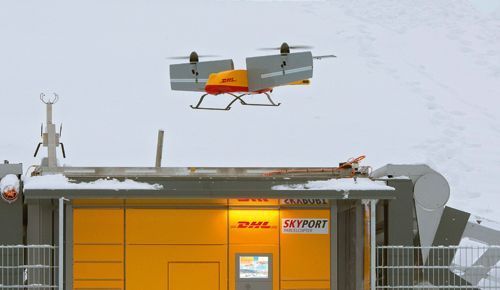Droning on and on
Technology
Richard B. from the Cambridge area will go down in history as the first customer to have goods delivered by electronic courier. The order was not impressive in itself – a drone delivered an Amazon Prime TV stick and a bag of Richard’s dog’s favourite biscuits. The entire despatch route, from where the order was received to its delivery, was recorded by a camera following the drone, so you can follow the route of the parcel travelling across the picturesque English countryside in (almost) real time.
Under English skies
The journey was kicked off with the order being received and the online payment completed by Richard. An employee of the Amazon warehouse retrieved the ordered goods from the shelf, scanned their bar codes and packed them into a normal box, which he then placed on a conveyor belt. In the next room a mechanical arm grabbed the box from the conveyor belt and placed it in the drone’s cargo bay. The drone then entered the warehouse on a rail track and when it reached the starting platform outside the engine started up and it flew into the sky. (An explanation is necessary here: an electronic drone is completely autonomic – it determines the route itself using only GPS and sensors placed in its body, while the ground operator simply follows its route on an electronic map.) The electronic courier landed on the lawn in front of Richard’s house, opened its cargo hold, pushed the parcel out and then promptly took off once again. Richard and the system’s operator received a notification that the goods had been delivered – and only 13 minutes had elapsed from the time of placing the order.
Amazon, however, ‘forgot’ to inform us that the drone featured in the film departed from the company’s research centre... 700m from Mr Richard’s home as the crow flies and that the delivery was carefully staged. But would things have been any different if former ‘Top Gear’ host Jeremy Clarkson, who now hosts a car show on the Amazon Prime channel, had been involved in advertising the service?
The system, which has been called Prime Air, is now being tested by Amazon for real. The British Civil Aviation Authority has only permitted Amazon’s drones to fly at a height of 120m within a 5-mile radius (app. 8 km) of the company’s research centre in Cambridgeshire. Amazon has guaranteed the delivery of a parcel of up to 5 lb (app. 2.3 kg) within 30 minutes of the placing of the order. According to the company, app. 85 pct of its goods are sold within this weight bracket. However, the system has a number of limitations.
“Our customers can order goods seven days a week, but we can only deliver them from dawn till dusk and only when the weather is good,” admits Av Raichura, the community affairs manager of British Amazon Prime Air, in an interview with ‘Eurobuild CEE’. “We do not have a permit for flights after dusk, when the wind is strong or when the visibility is poor or during rain or snowfall. However, when we have more data on the system’s security and reliability, we will be able to streamline it and extend the scope of the deliveries,” he insists.
Amazon has not disclosed the number of orders carried out since the launch of the service or revealed any more precise plans for the launch of the service in other countries, even though it is clear that Prime Air research centres also operate in the USA, Austria and Israel.
“We are continuing to work on entering other markets and would like to establish the Prime Air service all over the world,” Av Raichura told us.
Island hopping
Data for the testing of courier drones is now coming in from several other countries. Unmanned drones have been delivering post parcels
in Finland, Sweden and Switzerland; but it was German company DHL that pioneered these kinds of services in Europe. As early as December 2013, DHL Parcel’s parcelcopter device made its maiden voyage, 12 km across the rough waters of the North Sea to deliver medicine to the isle of Juist. “Our DHL 2.0 parcelcopter is one of the safest and most reliable flying machines in its class, fully equipped for fulfilling such a mission,” claims Jürgen Gerdes, the CEO of the post and eCommerce department at Deutsche Post DHL.
The parcelcopter was completely autonomic, i.e. the ground service did not have to do anything for the duration of the entire flight apart from monitoring it. However, the operator did have the option of taking control in the case of a malfunction.
Parcelcopter with its suspended, specially designed container for parcels, was both weather- and waterproof and flew at a height of 50m with a maximum speed of 64 km/h. It has enabled those on Juist island to order an air delivery of medicines from pharmacy chains on the mainland via the DHL website.
At the beginning DHL did not plan to integrate drones into its regular delivery system and it only used the parcelcopter for special tasks, such as the delivery of express parcels in emergency situations to locations inaccessible by conventional means of transport. However, after the next model was developed and the parcelcopter 3.0 had successfully completed tests, it was added to the company’s main service. The drone was integrated with a ‘packstation’ transceiver device, which is a combination of a parcel machine and a landing field. The way it works should by now be familiar – a parcel in a regular container is pushed into a post box and then automatically picked up by a drone and taken to another packstation by air. Packstations have been opened in the Bavarian towns of Reit im Winkl and Alm, which are around 8 km away from each other “as the drone flies” (around10 km by road). The drone not only had to contend with the capricious weather conditions of the Alps but also with some considerable changes in altitude, as one of the towns is in a valley and the other on a plateau. For over three months the system flawlessly delivered 130 parcels between the stations within 8 minutes – compared to about half an hour in a car over the same distance.
Taking off (or not) in Poland
Even though drones can be seen in Polish skies more and more often, drone-based deliveries are still in their infancy in this country. Tentative attempts have been undertaken by a variety of different parties, but these tend to be mere demonstrations and not serious tests. “Drone-based deliveries would seem to be an interesting solution from the marketing point of view,” admits Szymon Łukasik, an associate director in the retail department for tenant representation at CBRE. “At least at the beginning many customers will want to experience the thrill of using a new technology which, almost literally, knocks on their door,” he adds.
More than a year ago the pizzaportal.pl platform for ordering meals online carried out the first drone-based delivery in Warsaw. “We do not expect this form of delivery to be widely used; however, we can see some areas where it could be utilised,” Lech Kaniuk, the managing director of the portal at the time, said. The drone delivered a 2 kg box of sandwiches around 300m along the Vistula embankment from the Średnicowy Bridge to Poniatowski Bridge. The company then made an announcement about the possible future inclusion of drones into its regular delivery system, but nothing has since come of this.
Apart from their potential for deliveries, professional drones also have other uses. The Civil Aviation Authority has been receiving enquiries from service providers about obtaining licences for the commercial use of unmanned machines. “These are usually related to photography and airborne filming. Drones are also increasingly popular in various geodetic fields and for checking the state of electric grids and pipelines,” explains Marta Chylińska of the Civil Aviation Authority. “They are also used in the construction industry to check the progress or quality of work being carried out – for example, drones equipped with thermal imagining cameras can check how much heat is escaping from a building. There have also been some trial deliveries of blood for hospitals,” she adds. Post office operators, however, are sceptical about the potential of drones. “There is an impassable economic barrier – the transportation of letters and the majority of parcels by unmanned flying vehicles is simply too expensive,” believes Rafał Brzoska, the president of the Integer Group. “You can imagine drones delivering express parcels or flying to places that are hard to access, but this method is considerably more expensive than conventional means and so it is unlikely to be used on a large scale,” he emphasises.
The money is not the only problem. A few years ago Integer carried out a simulation for a hypothetical situation in which express post parcels in London were to be exclusively delivered by drones. Because as many as half a million express parcels are delivered in the city every day and one unmanned aircraft can deliver around 150 parcels a day, more than 3,000 drones would have to fly over London for 24 hours! Such air traffic in a large metropolis would simply be impossible to coordinate and could be a recipe for disaster.
Clause for concern
Security measures and aviation regulations are also among the reasons why drones have so far failed to “take off” as a delivery method in Poland. “We are at a time when there has been a dramatic increase in the number of users of unmanned aircraft. These are commercial users, who use drones for business purposes, i.e. they are work tools, but there are also private users who consider this as a hobby or a form of entertainment,” explains Mikołaj Karpiński of the Polish Air Navigation Services Agency. “However, it needs to be remembered that in each case anyone piloting a drone is an air space user – and that a drone is an aircraft and thus subject to aviation law,” he adds.
The Polish Civil Aviation Authority has launched its ‘Fly Wisely, Be Safe’ campaign (www.latajzglowa.pl) aimed at teaching the principles of safe drone flying. The conditions and requirements for flying models and unmanned aircraft used in VLOS conditions (Visual Line of Sight) are included in annexes 6 (flying models) and 6a (unmanned aircraft used for purposes other than sport and recreation) of a directive by the Ministry of Transport, Construction and Naval Economy of March 26th, 2013 on the exclusion of some regulations of the Aviation Law act concerning certain types of aircraft and on the conditions and requirements for their usage.
The principles themselves are not that difficult to absorb. Using a drone as a hobby involves controlling it within your sight and in open space, but you cannot fly it near airports (closer than 6 km away from the perimeter fence), above people, in cities (this applies to models weighing more than 600 grams) and above roads. Do they make sense? Absolutely. The regulations for professional flights are slightly more complicated, even though they mostly concern the drone’s equipment – it has to have a label bearing the name of the owner, warning lights and a system to ensure its safe descent in the case of a malfunction.
The crux of the matter, however, lies elsewhere. Polish law simply does not recognise the existence of autonomic drones (controlled by sensors placed in the aircraft and a GPS module) and does not permit flights out of the operator’s sight. The above-mentioned Ministry of Transport directive of 2013 states that “unmanned aircraft can only operate within the range of vision”. The operator must continue to ensure “full control of the flight, particularly via radio remote control. However, the legislator has left open one loophole: one of the clauses states that “upon justified request, in particular in the cases of show, record or experimental flights, the president of the Civil Aviation Authority may exempt a given entity from the obligation to meet some of these requirements,.” And yet, as we have been informed by the Civil Aviation Authority, so far not one company has requested any exemptions from these limitations.
It should come as no surprise, therefore, that even though the topic of drone-based deliveries has arisen from time-to-time in Poland in the last few years, nothing much is actually being done on this issue – and so the popularisation of unmanned aircraft has been extremely slow. Does the current legal situation make it possible for someone to launch a drone-based goods delivery service? “This would be quite a difficult but not an impossible task under the law as it currently stands,” admits Marta Chylińska of the Civil Aviation Authority.
But perhaps the situation is set to change. Work is currently being carried out by the European Union on regulations focused on the concept known as ‘U-Space’. “This is a special ICT environment in which drones move around a city’s airspace in as automated a mode as possible,” explains Marta Chylińska. The concept is to be made public in around six months’ time and the advent of such a system would be a breakthrough in terms of using drones in various sectors of the economy. “In my opinion, autonomic cars for parcel deliveries have the greater potential. And this is where I see the real future for deliveries rather than with drones,” concludes Rafał Brzoska of Integer.





















































